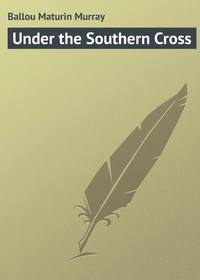 полная версия
полная версияThe New Eldorado. A Summer Journey to Alaska
CHAPTER III
Norris Geyser Basin. – Fire beneath the Surface. – A Guide’s Ideas. – The Curious Paint Pot Basin. – Lower Geyser Basin. – Boiling Springs of Many Colors. – Mountain Lions at Play. – Midway Geyser Basin. – “Hell’s Half Acre.” – In the Midst of Wonderland. – Old Faithful. – Other Active Geysers. – Erratic Nature of these Remarkable Fountains.
A pleasant drive of twenty miles in a southerly direction from the Hot Springs Hotel, through the wildest sort of scenery, over mountain roads and beside gorgeous cañons, will take the visitor to the Norris Geyser Basin, a spot which promptly recalled to the writer somewhat similar scenes witnessed at the aboriginal town of Ohinemutu, in the northern part of New Zealand. Clouds of sulphurous vapor constantly hang alike over both places, produced by a similar cause, though the scene here is far more vivid and demonstrative. This whole basin is dotted by hot water springs and fumaroles, which maintain an incessant hissing, spluttering, and bubbling, night and day, through the twelve months of the year. The water which issues from these sources is of various colors, according to the impregnating principle which prevails, the yellow sulphur vats being especially conspicuous to the sight and offensive to the smell. What a strange, weird place it is! No art could successfully imitate these extravagances of Nature. Some of the rills are cool, others are boiling hot; some are white, some pink or red, and one large basin, fifty feet across, is called the Emerald Pool, because of its intensely green color; yet it appears to be quite pure and transparent when a sample is taken out and examined. Each spring seems to be entirely independent of the rest, though all are situated so near to each other. An almost constant tremor of the earth is realized throughout this immediate region, as though only a thin crust separated the visitor from an active volcano beneath his feet; and, notwithstanding the various scientific theories, who can say that such is not actually the case?
“I know all about the idea that these eruptions of boiling water, steam, and sulphurous gases are produced by chemical action,” said our guide. “I’ve heard lots of scientific men talk about the subject, but I don’t believe nothing of the sort.”
“And why not?” we asked.
“Do you believe,” he said, “that chemical action in the earth could create power enough, first to bring water to 212° of heat, and then force it two hundred feet into the air a number of times every day in a column four or five feet in diameter, and keep it up for quarter of an hour at a time?”
“Well, it does seem somewhat problematical,” we were forced to answer.
“After living here summer and winter for six years,” he said, “I have seen enough to satisfy me that there is a great sulphurous fire far down in the earth below us, which, if the steam and power it accumulates did not find vent through the hundreds of surface outlets distributed all over the Park, would seek one by a grand volcanic outburst.”
“Put your hand on the ground just here,” he continued, as we walked over a certain spot where our footfall caused a reverberation and trembling of the soil.
“It is almost too hot for the flesh to bear,” we said, quickly withdrawing our hand.
“Too hot! I should say so. Now I don’t believe anything but a burning fire can produce such heat as that,” he added, with an expression of the face which seemed to imply, “I don’t believe you do either.”
“The original volcanic condition of this whole region seems also to argue in favor of your deductions,” we replied.
“That’s just what I tell ’em,” continued the guide. “Them big fires that first did the business for this neighborhood are still smouldering down below. You may bet your life on that.”
This rather startling idea is emphasized by a smoking vent close at hand, which is also constantly sending forth superheated steam and sulphurous gases, like the extinct volcano of Solfatara, near Naples. Sulphur crystals strew the ground, and are heaped up in small yellow mounds. Not far away an intermittent geyser bursts forth every sixty seconds from a deep hole in the rock-bed of the basin, showing a stream of water six inches in diameter, and sending the same skyward thirty or forty feet. Here also is a powerful geyser called the Monarch, which leaps into action with great regularity once in twenty-four hours, throwing a triple stream to the height of a hundred and thirty feet, and continuing to do so for the space of fifteen or twenty minutes. Beneath the sun’s rays all the colors of the prism are reflected in this vertical column of water, and not infrequently the distinct arch of a rainbow is suspended like a halo about its crown. Nature, even in her most fantastic caprice, is always beautiful.
There are several other high-reaching and powerful geysers in this vicinity, but we will not weary the reader by pausing to describe them.
Gibbon Paint Pot Basin is next visited, being a most curious area, measuring some twenty acres, more or less, situated in a heavily-wooded district, not far from Gibbon Cañon. Here is a most strange collection of over five hundred springs of boiling, splashing, exploding mud, exhibiting many distinct colors, which gives rise to the name it bears. One pot is of an emerald green, another is as blue as turquoise, a third is as red as blood, a fourth is of orange yellow, another is of a rich cream color and consistency. The visitor is struck by the singularity of this hot-spring system, which produces from vents so close together colors diametrically opposite. The earth is piled up about the seething pools, making small mounds all over the basin, and forming a series of pots of clay and silicious compounds. Near the entrance of Gibbon Cañon is a remarkable collection of extinct geysers; the tall, slim, crystallized structures, originating like the Liberty Cap already described, look like genii totem poles, corrugated by the finger of time, and forming significant monuments of bygone eruptions, while the surrounding volcanoes were slowly exhausting their fury. Even about these long-extinct geysers there is an atmosphere indicating their former intensity, though it is quite possible they may have been sleeping for ten centuries.
The locality known as the Lower Geyser Basin is filled with striking and somewhat similar volcanic exhibitions, though there are more hot springs here than other phenomena, the aggregate number being a trifle less than seven hundred, including seventeen active geysers. In some respects this spot exceeds in interest those previously visited, being more readily surveyed as a whole. The variety of form and the large number of these springs are remarkable. As a rule they are less sulphurous and more silicious than those already spoken of. Here, as at the terraces near the hotel, the last touch of beauty is imparted by the sun’s rays forcing themselves through the white vapory clouds which are thrown off by the mysteriously heated waters. One of the large basins, measuring forty by sixty feet, is filled with a sort of porcelain slime, notable for its soft rose tints and delicate yellow hues, which are brought out with magic effect under a cloudless sky. This basin has an elevation of over seven thousand feet above the level of the sea, and is surrounded by heavily-timbered hills which are four and five hundred feet higher. Numerous as these springs and geysers are, each one is strongly individualized by some special feature which marks it as distinctive from the rest, and renders it recognizable by the residents of the Park, but which, however interesting to the observing visitor, would only prove to be tedious if here described in detail.
While sitting at twilight on the piazza of the rude little inn where we passed the night in this basin, there came out from the edge of the wood on to a broad green plateau a couple of long tailed mountain lions. They were not quite full grown, and were of a tawny color. These creatures, savage and dangerous enough under some circumstances, seemed half tame and entirely fearless, playfully romping with each other, and exhibiting catlike agility. The proprietor of the inn told us that not long since, upon a dark night, they came to the house and attacked his favorite dog, killing and eating him, leaving only the bones to explain his disappearance in the morning. They, too, must have read the regulations, “No firearms permitted in the Park.”
The Midway Geyser Basin is situated a few miles directly south of that just spoken of, and contains an extraordinary group of hot springs, among which is the marvelous Excelsior Geyser, largest in the known world. It bursts forth from a pit two hundred and fifty feet in diameter, worn in the solid rock, and which is at all times nearly full of boiling water, above which there is constantly floating a dense column of steam, which rising slowly is borne away and absorbed by the atmosphere. The water which flows so continuously over the brim has formed a series of terraces beaming with beautiful tints. This stupendous fountain is intermittent, giving an exhibition of its startling powers at very irregular periods, when it is said to send up a column of water sixty feet in diameter to a height of from fifty to one hundred feet! So great is the sudden flood thus produced in the Firehole River, which is here between seventy-five and a hundred yards broad, that it is turned for the time being into a furious torrent of steaming, half-boiling water. The Excelsior has also a disagreeable and dangerous habit of throwing up hundred-pound stones and metallic débris with this great volume of water, while the surrounding earth vibrates in sympathy with the hidden power which operates so mysteriously. Visitors naturally hasten to a safe distance during these moments of extraordinary activity.
About midway between Firehole and the Upper Geyser Basin is a strange, unearthly, vaporous piece of low land, which is endowed with a name more expressive than elegant, being called “Hell’s Half Acre.” Here again it seems as if this spot is separated from the raging fires below by only the thinnest crust of earth, through which numerous boiling springs find riotous vent. The soil in many parts is burning hot, and echoes to the tread as though liable to open at any moment and swallow the venturesome stranger. During the season of 1888, a lady visitor who stepped upon a thin place sank nearly out of sight, and though instantly rescued by her friends, she was so severely scalded as to be confined to her bed for a month and more at the Mammoth Springs Hotel. The air is filled with fumes of sulphur, and the place would seem to be appropriately named. There are forty springs in this “Half Acre,” which, by the way, occupies ten times the space which the name indicates, where the seething and bubbling noise is like the agonized wailing of lost spirits. The place has another, and perhaps better, designation besides this satanic title, namely, Egeria Springs. Great is the contrast between the heavens above and the direful suggestions of the earth below, as we behold it under the serene beauty of the blue sky which prevails here in the summer months, and which renders camping out in the Park delightful. “You should come here during a thunder-storm,” said our companion, who is a dweller in this region. “I have done so twice,” he continued, “simply to witness the fitness of the association: rolling thunder overhead and flashes of lightning in the atmosphere, through which the boiling vats, hissing pools, and steaming fissures are seen in full operation, as though they were a part and parcel of the electric turmoil agitating the sky.”
It is impossible to appreciate these various phenomena in a single hurried visit. Like the Falls of Niagara, or the Pyramids of Gizeh, they must become in some degree familiar to the observer before he will be able to form a complete, intelligent, and satisfactory impression which will remain with him. One cannot grasp the full significance of such accumulated wonders at sight. We look about us among the green trees that border the open areas, surprised to behold the calm sunshine, the tuneful birds, and the chattering squirrels, moved by their normal instincts, utterly regardless of these myriad surrounding marvels.
The grandest spouting springs are to be found in Upper Geyser Basin, where there are twenty-five active fountains of this character. Here is situated the famous “Old Faithful,” which, from a mound rising gradually about six or eight feet above the surrounding level, emits a huge column of boiling water for five or six minutes in each hour with never-failing regularity, while it gives forth at all times clouds of steam and heated air. The height reached by the waters of this thermal fountain varies from eighty to one hundred and twenty feet, and it has earned its expressive name by never failing to be on time. It seemed, somehow, to be a more satisfactory representative of the spouting spring phenomenon than any other in the entire Park, though it would be difficult to say exactly why. Its prominent position, dominating the rest of the geysers of the basin, gives it special effect. Irrespective of all other similar exhibitions, the stately column of “Old Faithful” rises heavenward with splendid effect in the broad light of day, or in the still hours of the night, once in every sixty minutes, as uniformly as the rotation of the second-hand of a watch. The effect was ghostly at midnight under the sheen of the moon and the contrasting shadows of the woods near at hand, while not far away, across the Firehole River, the lesser geysers were exhibiting their erratic performances, casting up occasional crystal columns, which glistened in the silvery light like pendulous glass. There is quite a large group of geysers in this immediate vicinity, which perform with notable regularity at stated periods. There is one called the Beehive, because of its vent, which has a resemblance to an old-fashioned straw article of the sort, the crater being about three feet in height. The author saw this spring throw up a stream three feet in diameter nearly or quite two hundred vertical feet for eight or ten minutes, when it gradually subsided. There are over four hundred geysers and boiling springs in this basin. Among them is the Giantess, situated four hundred feet from the Beehive, which does not display its powers oftener than once in ten or twelve days; but when the eruption does take place, it is said to exceed all the rest in the height which it attains and the length of time during which it operates. It has no raised crater, but comes forth from a vent even with the surface of the ground, thirty-four feet in length and twenty-four in width. When it is in action, so great is the force expended that miniature earthquakes are felt throughout the immediate neighborhood. There are seen, not far away, the Lion, Lioness, Young Faithful, the Grotto, the Splendid, etc., each one more or less operative. We have by no means enumerated all the active fountains in this basin, seeking only to designate their general character. However well prepared for the outburst, one cannot but feel startled when a geyser suddenly rises, mysteriously and ghost-like, close at hand, from out the deep bowels of the earth, its white form growing taller and taller, while the spray expands like weird and shrouded arms. To heighten this sepulchral effect the atmosphere is full of sulphurous vapors, while strange noises fall upon the ear like subterranean thunder. What puzzling mysteries Nature holds concealed in her dark, earthy bosom!
Let us not forget to mention, in this connection, one of the hugest fountains of the Firehole Basin, namely, the Grand Geyser, which is placed next to the Excelsior in size and performance. This fountain has no raised cone, and operates once in about thirty-six hours. Of course the visitor is not able to see each and all of these strange fountains in operation. He might remain a month upon the ground and not do so; consequently, he is obliged to take some of the dimensions and performances on trust; but most of the statements which are made to him can easily be verified.
When this Grand Geyser is about to burst forth, the deep basin, which is twenty feet and more across, first gradually fills with furiously boiling water until it overflows the brim; then it becomes shrouded by heavy volumes of steam, out of which come several loud reports, like the discharge of a small cannon, when suddenly the whole body of water is lifted, and a column ten or twelve feet in diameter rises to a height of ninety feet, from the apex of which a lesser stream mounts many feet higher, until the earth trembles with the force of the discharge and falling water as it rushes towards the river. This strange exhibition lasts for eight or ten minutes, then the fountain slowly subsides, with hoarse mutterings, like some retreating and overmastered wild beast, growling sullenly as it disappears.
It will thus be seen that these geysers vary greatly in their action, in the duration of their eruptions, and in the intervals which elapse between the performances. Some of them labor as though the water was slowly pumped up from vast depths, some burst forth with full vigor to their highest point at once, while others become exhausted with a brief effort. There are a few that subside only to again commence spouting, being thus virtually continuous; but these are not of such power as to throw their streams to a great height. One group of this sort is called the Minute Men, some of which spout sixty times within the hour; others eject small streams incessantly.
This immediate valley is very irregular in surface and thickly wooded in parts, showing also the ruins of many extinct geysers. It is a dozen miles long and between two and three wide, literally crowded with wonders from end to end. It contains a collection of boiling and spouting springs on a scale which would belittle all similar phenomena of the rest of the known world, could they be brought together.
As the reader will have understood, the period of activity with all the geysers is more or less irregular, except in the instance of Old Faithful. We have no knowledge of a simultaneous eruption having ever taken place. Many of these active springs which now exist will, doubtless, sooner or later subside and new ones will form to take their places, a process which has been going on, no one can even guess for how many ages.
CHAPTER IV
The Great Yellowstone Lake. – Myriads of Birds. – Solitary Beauty of the Lake. – The Flora of the Park. – Devastating Fires. – Wild Animals. – Grand Volcanic Centre. – Mountain Climbing and Wonderful Views. – A Story of Discovery. – Government Exploration of the Reservation. – Governor Washburn’s Expedition. – “For the Benefit of the People at Large Forever.”
In the southern section of the Yellowstone Park, near its longitudinal centre, is one of the most beautiful yet lonely lakes imaginable, framed in a margin of sparkling sands, and surrounded by Alpine heights. One stretch of the shore about five miles long is called Diamond Beach; the volcanic material of which it is formed, being entirely obsidian, reflects the sun’s rays like brilliant gems, while the beach is caressed by wavelets scarcely less bright. Surrounded by many wonders, the lake is itself a great surprise, lying in the bosom of rock-ribbed mountains at an elevation of nearly eight thousand feet above the sea. We know of but one other large body of water on the globe at any such height, namely, Lake Titicaca, in South America, famous in Peruvian history. The Yellowstone Lake is always of crystal clearness, and is fed from the eternal snow that piles itself up on the lofty peaks which surround it, and which are sharply outlined in all directions against the blue of the sky. The outlet of the lake is the Yellowstone River, which issues from the northern end, while the Upper Yellowstone runs into it on the opposite side. The lake is twenty-two miles long by fifteen in width, and has an area of a hundred and fifty square miles. Its greatest depth is three hundred feet, and it is overstocked with trout, many of which, unfortunately, are infested by a parasitic worm which renders them unfit for food; but this is not the case with all the fish; a large portion are good and wholesome. Geologists find sufficient evidence to satisfy them that this lake, now narrowed to the dimensions just given, in ancient times covered two thirds of the present Park. Aquatic birds abound upon its broad surface, and build their myriad nests on its green islands. They are of many species, comprising geese, cranes, swans, snipe, mallards, teal, curlew, plover, and ducks of various sorts. Pelicans swim about in long white lines; herons, in their delicate ash-colored plumage, stand idly on the shore, while ermine-feathered gulls fill the air with their loud and tuneless serenade. Hawks, kingfishers, and ravens also abound on the shore, the first-named watching other birds as they rise from the water with fish, which they make it their business, freebooter-like, to rob them of. The lake has many thickly-wooded islands, and there are several long, pine-covered promontories which stretch out in a graceful manner from the mainland, the whole forming a grand primeval solitude. Now and again a solitary eagle, on broad-spread pinions, sails away from the top of some lofty pine on the mountain side to the deep green seclusion of the nearest island. Even the presence of this proud and austere bird only serves to emphasize the grave and solemn loneliness which rests upon the locality.
It is a charming feature of this placid lake which causes it to gather into its bosom a picture of all things far and near: the clouds, “those playful fancies of the mighty sky,” seem to float upon its surface; the blue of the heavens is reflected there; the tall peaks and wooded slopes mirror themselves in its depths. As we look upon the lake through the purple haze of sunset, a picture is presented of surpassing loveliness, tinted with blue and golden hues, which creep lovingly closer and closer about the quiet isles; while there come from out the forest resinous pine odors, delightfully soothing to the senses, accompanied by the soft music of swaying branches, and the low drone of insect life.
To linger over such a scene is a joy and an inspiration to the experienced traveler, who, in wandering hither and thither upon the globe, places an occasional white stone at certain points to which memory turns with never-failing pleasure. Thus he recalls a sunrise over the silvery peaks of the grand Himalayan range; a thrilling view from the Mosque of Mahomet Ali at Cairo, localizing Biblical story; or a summer sunset-glow on the glassy mirror of the Yellowstone Lake.
Along the mountain side, east of the lake, are ancient terraces, indented shorelines, and other evidences which clearly prove that, at no very remote geological period, the surface of this grand sheet of water was at least five or six hundred feet higher than it is at the present time. Nearly two hundred square miles of the Park are still covered by lakes.
As to the flora of the Yellowstone Park, seventy-five per cent. of the whole area seems to be covered by dense forests, the black fir being the most plentiful, often growing to three or four feet in diameter and a hundred and fifty feet in height. The white pine is the most graceful among the indigenous trees, and is always remarkable for its stately symmetrical beauty. The thick groves of balsam fir are particularly fine and fragrant, while the dwarf maples and willows are charming features as they mingle abundantly with larger and more pretentious trees. Wild flowers, Nature’s bright mosaics, are found in great variety during the summer, though there is rarely a night in this neighborhood without frost, while the winters are truly arctic in temperature. The larkspur, columbine, harebell, lupin, and primrose abound, with occasional daisies and other blossoms. Yellow water-lilies, anchored by their fragile stems, profusely sprinkle and beautify the surface of the shady pools. Exquisite ferns, lichens, and velvety mosses delight the appreciative eye in many a sylvan nook which is only invaded by squirrels and song-birds.
Here, as in the valley of the Yosemite, it is melancholy to see the track of devastating fires caused by the half-extinguished blaze left by careless camping parties. It is difficult to realize how intelligent people can be so wickedly reckless as to cause such destruction. Many a forest monarch stands bereft of every limb by the devouring flames, and large areas are entirely denuded of growth other than the shrubbery which springs up quickly after a sweeping fire in the woods, as though Nature desired to cover from sight the devastating footsteps of the Fire King. The grasses grow luxuriantly, especially alpine, timothy, and Kentucky blue grass.











